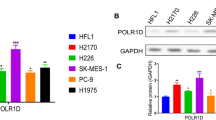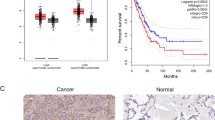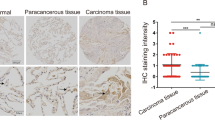Abstract
Partner of sld five 1 (PSF1) is a member of the heterotetrameric complex termed GINS. Previous studies have shown that PSF1 is unregulated in several cancer and associated with tumor malignant characters. However, the effects of PSF1 in lung cancer are still unclear. The goal of this study was to investigate the effects of PSF1 on the proliferation capacities of lung cancer. To start with, expression of PSF1 in 22 human lung cancer samples and adjacent non-tumor samples were detected by real-time RT-PCR and Western blotting. Our results showed that PSF1 was overexpressed in lung cancer samples compared to adjacent non-tumor samples. To achieve better insights of PSF1 functions in lung cancer cells, we used PSF1-specific small interfering RNA (siRNA) successfully inhibit the expression of PSF1 in messenger RNA (mRNA) and protein levels. In addition, we used lung cancer cell lines with different p53 gene background (p53 null and p53 wild-type). The results showed that knockdown of PSF1 inhibited cell proliferation and caused cell cycle arrest of lung cancer cells in a p53-independent manner. Our data indicated that PSF1 is functionally involved in lung cancer cell proliferation and is a potential target for lung cancer therapy.
Similar content being viewed by others
Avoid common mistakes on your manuscript.
Introduction
Lung cancer is one of the most common and lethal human malignancies worldwide, with 1.4 million deaths every year, in the world [1, 2]. In China, the incidence and mortality of lung cancer has continued to increase in recent years [3]. Human lung cancers are subdivided into small cell lung cancer and non-small cell lung cancer, the latter of which accounts for more than 85 % of all lung cancer cases, and adenocarcinoma is the most common subtype [4]. Owing to the limitations of the current screening techniques, most patients with lung cancer are diagnosed at advanced disease stage. Despite surgical resection and advances in radiotherapy and chemotherapy, long-term survival rates remain extremely poor over the past years [5].
Gene target therapy is a new way for cancer therapy and the key point of gene target therapy is searching for specific and efficient targets. Thus, a new specific and efficient molecular target is essential for reducing the mortality of this devastating malignancy.
Partner of sld five 1 (PSF1), an evolutionarily conserved DNA replication factor, is a member of the heterotetrameric complex termed GINS comprising Sld5, PSF1, PSF2, and PSF3 [6]. Loss of PSF1 causes embryonic lethality around the implantation stage [7]. Several recent reports have suggested that PSF1 is required for acute proliferation of cells, particularly immature cells such as stem cells and progenitor cells and that this protein is also used as a marker for the detection of cancer stem cells [6, 8]. Moreover, previous studies have suggested that PSF1 and some other GINS complex members are unregulated in cancer and associated with tumor malignancy characters [9–12].
To achieve better insights of PSF1 functions in lung cancer, in this study, we examined the expression levels of PSF1 in human lung cancer and adjacent non-tumor samples. Additionally, we examined the biological roles of PSF1 by modulating the PSF1 expression level in lung cancer cell lines using small interfering RNA (siRNA).
Materials and methods
Reagents and antibodies
Rabbit polyclonal antibodies to PSF1 were from Abcom. The rabbit polyclonal antibody to GAPDH and goat anti-rabbit IgG/HRP were from Zhongshan Biotechnology Co. (Beijing, China). The protease inhibitor cocktail, 3-(4,5-dimethylthiazol-2-yl)-2,5-diphenyltetrazolium bromide (MTT), and all other chemicals were obtained from Sigma.
Specimens and cell lines
Twenty-two pairs of human lung adenocarcinoma samples and matched adjacent non-tumor tissues were obtained from patients who underwent surgical resection. All samples were immediately frozen and stored at −80 °C. Informed consent was obtained from all patients, and this study was approved by our institutional review board. Human lung cancer cell lines, A549 and H1299, were obtained from Cell Bank, Chinese Academy of Sciences (Shanghai, China) and maintained in RPMI-1640 medium containing 10 % fetal bovine serum (Gibco, Grand Island, NY, USA) at 37 °C in a humidified atmosphere consisting of 5 % CO2.
Transfection of siRNA
siRNA specific to human PSF1, negative control siRNA, and Lipofectamine 2000 were purchased from Invitrogen (Carlsbad, CA, USA; HSS145319). Transfection of siRNA was carried out according to the procedure recommended by the manufacturer.
Quantitative real-time polymerase chain reaction analysis
Total RNA was isolated from the human samples and different cell groups using the RNAfast200 Total RNA Extract Kit (Fastgene, Shanghai, China), and 2 μg RNA was reverse transcribed to cDNA by the RevertAid™ First Strand cDNA Synthesis Kit (Fermentas, MBI, Lithuania). cDNA was mixed with SYBR Green Master Mix, and real-time PCR was done with appropriate primers using a real-time detection system (ABI 7500, Applied Biosystems). Relative expression levels of PSF1 messenger RNA (mRNA) were calculated by normalizing to the level of GAPDH mRNA. PCR primers were used as follows: primers for the psf1 gene were 5′- CCGGTTGCTTCGGATTAGAG -3′ (forward) and 5′- CTCCCAGCGACCTCATGTAA -3′ (reverse). Primers for the GAPDH gene were as follows: 5′- TGCACCACCAACTGCTTAGC -3′ (forward) and 5′- GGCATGGACTGTGGTCATGAG-3′ (reverse). Relative mRNA levels are presented as 2−ΔCT. Each reaction was performed three times.
Western blotting
Cells and human samples were lysed in ice-cold RIPA lysis buffer (1 % NP-40, 0.1 % sodium dodecyl sulfate (SDS), 0.5 % sodium deoxycholate, 150 mmol/L NaCl, and 10 mmol/L Tris–HCl) containing a protease inhibitor cocktail. The total protein concentration was determined using a Bio-Rad protein assay reagent (Bio-Rad, Hercules, CA, USA). Equivalent amounts of proteins were then separated by 10 % SDS-PAGE and transferred to nitrocellulose membranes (Bio-Rad, Hercules, CA, USA). After blocking in Tris-buffered saline (TBS) containing 5 % non-fat milk, the membranes were incubated with primary antibodies at 4 °C overnight and then with horseradish peroxidase (HRP)-conjugated secondary antibody (Zhongshan, Beijing, China) at a dilution of 1:3000 at room temperature for 1 h. Signals were detected on X-ray film using the ECL detection system (Pierce, Rockford, IL, USA). Equal protein loading was assessed by the expression of GAPDH.
Cell proliferation assay
Cell viability was measured using MTT assay. Cells were seeded at 5 × 103 per well in 96-well flat-bottom plates 1 day before transfection. The MTT assay was performed just before transfection as well as 24, 48, and 72 h after transfection. For the assay, 20 uL of 5 mg/ml MTT was added to each well, and then the cells were incubated for 4 h before 180 μL DMSO was added. After the insoluble crystals were completely dissolved, the absorbance values at 570 nm were measured using a microplate reader (Bio-Rad, Hercules, CA, USA).
Cell cycle analysis
Cell cycle progression was determined by flow cytometry of propidium iodide (PI)-stained cells on a FACS Calibur flow cytometer (Becton Dickinson, San Jose, CA, USA). Forty-eight hours after transfection, cells were trypsinized, collected, and washed twice with PBS. Then, the cells were fixed with cold 70 % ethanol for at least 1 h at 4 °C. Before flow cytometric analysis, the cells were incubated with RNase at 0.01 mg/ml and PI at 50 μg/ml in the dark at room temperature for 30 min. A total of 104 cells were analyzed for each sample. Cell cycle analysis was performed by ModFit LT version 3.0 software (Verity Software House, Topsham, ME, USA). Experiments were done in triplicate.
Soft agar colony formation assay
Cells were transfected with the PSF1 or mock siRNA. Twenty-four hours after transfection, cells were trypsinized, and 5 × 103 cells were mixed with a 0.3 % agar solution in RPMI-1640 containing 10 % FBS and layered on top of a 0.6 % agar layer in six-well tissue culture plates. The plates were incubated for 2–3 weeks at 37 °C in a 5 % CO2 atmosphere until colonies were formed. Only colonies containing more than 50 cells were counted. The results were reported as the mean number of colonies observed in five randomly chosen microscope fields. Experiments were done in triplicate.
Statistical analysis
Results are expressed as mean ± standard deviation (SD). Statistical evaluation of the data was performed with Student’s t test. Two-tailed P < 0.05 was considered statistically significant. All analyses were performed using SPSS software version 13.0 (SPSS Inc., Chicago, IL, USA).
Results
Expression of PSF1 in lung cancer and adjacent non-tumor samples
In this study, psf1 mRNA was found to be significantly overexpressed in lung cancer samples than adjacent non-tumor samples (P < 0.05) (Fig. 1a). To further confirm these data, we evaluated the protein expression of PSF1 in these samples by Western blotting. Similar to gene expression pattern, PSF1 was obviously increased in lung cancer samples as compared with adjacent non-tumor samples (P < 0.05) (Fig. 1b).
siRNA silencing of PSF1 at the mRNA and protein levels
A549 and H1299 cells were transiently transfected with PSF1 or mock siRNA. Total RNA and protein were isolated and analyzed by quantitative real-time polymerase chain reaction (qPCR) and Western blotting at 48 and 72 h after transfection. Compared with mock transfected cells, the expression of PSF1 was obviously suppressed in cells transfected with PSF1 siRNA at both the mRNA and protein levels (P < 0.05) (Fig. 2).
Downregulation of PSF1 expression inhibited cell growth and arrested cell cycle
As shown in Fig. 3, downregulation of PSF1 expression in lung cancer cells caused significant inhibition of cell proliferation compared with mock siRNA transfected cells (P < 0.05). Flow cytometry was used to assess whether downregulation of PSF1 expression in lung cancer cells was associated with alterations in cell cycle progression. As shown in Fig. 4, the percentage of lung cancer cells in S-phase in PSF1 siRNA transfected cells was decreased relative to mock transfected cells (P < 0.05). These results indicated that downregulation of PSF1 expression suppressed cell cycle progression in lung cancer cells.
Downregulation of PSF1 expression inhibited colony formation
To determine whether PSF1 expression knockdown affected anchorage-independent lung cancer cell growth, colony formation assay was performed. As shown in Fig. 5, downregulation of PSF1 inhibited anchorage-independent growth as evidenced by a decrease in the number of colonies on soft agar in the PSF1 siRNA-transfected cells compared to mock siRNA-transfected cells (P < 0.05).
Discussion
GINS complex is a highly evolutionarily conserved tetrameric complex, composed of SLD5, PSF1, PSF2, and PSF3, which has been reported to participate in both the initiation and elongation phases of DNA replication [13]. Recent studies show that several GINS components are highly expressed in different kinds of cancer and related to poor prognosis and tumor progression [9, 14, 15, 11, 12].
PSF1, one member of GINS complex, has important roles in cell proliferation, organogenesis, and cancer. PSF1 expression is tightly associated with proliferation and is extinguished in differentiated or resting cells that have exited the cell cycle. In adult tissues, the expression of PSF1 is restricted to a few other highly proliferative tissues, including reproductive tissues, bone marrow, and thymus [7]. However, in this study, we found that PSF1 is highly expressed in lung cancer tissue and cell lines. These data indicate that PSF1 is a potential specific target for lung cancer therapy.
To elucidate the effect of PSF1 in lung cancer, in this study, we modulated PSF1 expression level in lung cancer cell lines with siRNA. Our results demonstrated that downregulation of PSF1 expression could inhibit cell proliferation and induce cell cycle arrest in lung cancer cells, indicating that PSF1 is a potential therapeutic target for the treatment of lung cancer.
Abnormal cell proliferation is an important characteristic of malignant tumors, which suggests that cell cycle arrest could be an effective method of therapy for malignant tumors. Previous studies show that the upregulation of PSF1 promotes the growth of breast cancer and hepatocellular carcinoma cells [16, 11]. In this study, we also found that downregulation of PSF1 expression could inhibit cell proliferation. Furthermore, cell cycle analysis showed that the percentage of G0–G1 phase cells was significantly elevated but S-phase cells decreased in PSF1 siRNA group compared with mock siRNA group, indicating an S-phase arrest of the cell cycle.
p53, a tumor-suppressor protein, plays an essential role in preventing cancer development by inducing cell cycle arrest or apoptosis in response to cellular stress. In more than half of human caner tissues, p53 is directly inactivated by mutations [17, 18]. Previous studies also show that activation of p53 can lead to suppression of cell growth [19, 20]. Therefore, we hypothesized that the PSF1 knockdown-induced cell growth inhibition may require activation of p53 protein in lung cancer cells. To confirm this hypothesis, we used human lung cancer cell lines A549 (p53 null) and H1299 (p53 wild-type) in this study. Our results indicated that downregulation of PSF1 expression induced cell cycle arrest in both kinds of cells, which means PSF1 knockdown induced cell growth inhibition in a p53-independent pathway. So, further studies are needed to clarify the mechanism for PSF1 knockdown-induced cell cycle arrest in lung cancer cells.
In conclusion, our results showed that downregulation of the PSF1 expression level in lung cancer cells by PSF1-specific siRNA decreased cell proliferation ability and induced cell cycle arrested in a p53-independent pathway. This study provides evidence that PSF1 may serve as a new target for lung cancer therapy.
References
Jemal A, Bray F, Center MM, Ferlay J, Ward E, Forman D. Global cancer statistics. CA Cancer J Clin. 2011;61(2):69–90. doi:10.3322/caac.20107.
Blanco R, Maestu I, de la Torre MG, Cassinello A, Nunez I. A review of the management of elderly patients with non-small-cell lung cancer. Ann Oncol Off J Eur Soc Med Oncol ESMO. 2014. doi:10.1093/annonc/mdu268.
Jemal A, Center MM, DeSantis C, Ward EM. Global patterns of cancer incidence and mortality rates and trends. Cancer epidemiology, biomarkers & prevention: a publication of the American Association for Cancer Research, cosponsored by the Am Soc Prevent Oncol. 2010;19(8):1893–907. doi:10.1158/1055-9965.EPI-10-0437.
Huang CH, Chang PM, Lin YJ, Wang CH, Huang CY, Ng KL. Drug repositioning discovery for early- and late-stage non-small-cell lung cancer. BioMed Res Int. 2014;2014:193817. doi:10.1155/2014/193817.
Reungwetwattana T, Dy GK. Targeted therapies in development for non-small cell lung cancer. J Carcinog. 2013;12:22. doi:10.4103/1477-3163.123972.
Nagahama Y, Ueno M, Miyamoto S, Morii E, Minami T, Mochizuki N, et al. PSF1, a DNA replication factor expressed widely in stem and progenitor cells, drives tumorigenic and metastatic properties. Cancer Res. 2010;70(3):1215–24. doi:10.1158/0008-5472.CAN-09-3662.
Ueno M, Itoh M, Kong L, Sugihara K, Asano M, Takakura N. PSF1 is essential for early embryogenesis in mice. Mol Cell Biol. 2005;25(23):10528–32. doi:10.1128/MCB. 25.23.10528-10532.2005.
Matsui T, Kinugasa Y, Tahara H, Kanakura Y, Takakura N. Possible role of mural cell-covered mature blood vessels in inducing drug resistance in cancer-initiating cells. Am J Pathol. 2013;182(5):1790–9. doi:10.1016/j.ajpath.2013.01.019.
Hokka D, Maniwa Y, Tane S, Nishio W, Yoshimura M, Okita Y, et al. Psf3 is a prognostic biomarker in lung adenocarcinoma. Lung Cancer. 2013;79(1):77–82. doi:10.1016/j.lungcan.2012.10.001.
Wen JZ, Han XY, Wei B, Zhang S, Wei HB. Expression of PSF1 in colon cancer tissues and its effect on the proliferation of colon cancer cells. Zhonghua wei chang wai ke za zhi = Chin J Gastrointest Surg. 2013;16(1):70–4.
Zhou L, Sun XJ, Liu C, Wu QF, Tai MH, Wei JC, et al. Overexpression of PSF1 is correlated with poor prognosis in hepatocellular carcinoma patients. Int J Biol Markers. 2014. doi:10.5301/jbm.5000105.
Obama K, Ura K, Satoh S, Nakamura Y, Furukawa Y. Up-regulation of PSF2, a member of the GINS multiprotein complex, in intrahepatic cholangiocarcinoma. Oncol Rep. 2005;14(3):701–6.
Pai CC, Garcia I, Wang SW, Cotterill S, Macneill SA, Kearsey SE. GINS inactivation phenotypes reveal two pathways for chromatin association of replicative alpha and epsilon DNA polymerases in fission yeast. Mol Biol Cell. 2009;20(4):1213–22. doi:10.1091/mbc.E08-04-0429.
Nagahama Y, Ueno M, Haraguchi N, Mori M, Takakura N. PSF3 marks malignant colon cancer and has a role in cancer cell proliferation. Biochem Biophys Res Commun. 2010;392(2):150–4. doi:10.1016/j.bbrc.2009.12.174.
Ryu B, Kim DS, Deluca AM, Alani RM. Comprehensive expression profiling of tumor cell lines identifies molecular signatures of melanoma progression. PLoS One. 2007;2(7):e594. doi:10.1371/journal.pone.0000594.
Nakahara I, Miyamoto M, Shibata T, Akashi-Tanaka S, Kinoshita T, Mogushi K, et al. Up-regulation of PSF1 promotes the growth of breast cancer cells. Genes Cells Devoted Mol Cell Mech. 2010;15(10):1015–24. doi:10.1111/j.1365-2443.2010.01442.x.
Elias J, Dimitrio L, Clairambault J, Natalini R. The p53 protein and its molecular network: modelling a missing link between DNA damage and cell fate. Biochimica et biophysica acta. 2014;1844(1 Pt B):232–47. doi:10.1016/j.bbapap.2013.09.019.
Hong B, van den Heuvel AP, Prabhu VV, Zhang S, El-Deiry WS. Targeting tumor suppressor p53 for cancer therapy: strategies, challenges and opportunities. Curr Drug Targets. 2014;15(1):80–9.
Loayza-Puch F, Drost J, Rooijers K, Lopes R, Elkon R, Agami R. p53 induces transcriptional and translational programs to suppress cell proliferation and growth. Genome Biol. 2013;14(4):R32. doi:10.1186/gb-2013-14-4-r32.
Kumar S. P53 induction accompanying G2/M arrest upon knockdown of tumor suppressor HIC1 in U87MG glioma cells. Mol Cell Biochem. 2014;395(1–2):281–90. doi:10.1007/s11010-014-2137-9.
Acknowledgments
This project was supported by China Postdoctoral Science Foundation funded project (2013M532058) and Key Science and Technology Project of Shaanxi Province (2013K12-08-01).
Conflicts of interest
None
Author information
Authors and Affiliations
Corresponding author
Rights and permissions
About this article
Cite this article
Zhang, J., Wu, Q., Wang, Z. et al. Knockdown of PSF1 expression inhibits cell proliferation in lung cancer cells in vitro. Tumor Biol. 36, 2163–2168 (2015). https://doi.org/10.1007/s13277-014-2826-8
Received:
Accepted:
Published:
Issue Date:
DOI: https://doi.org/10.1007/s13277-014-2826-8









